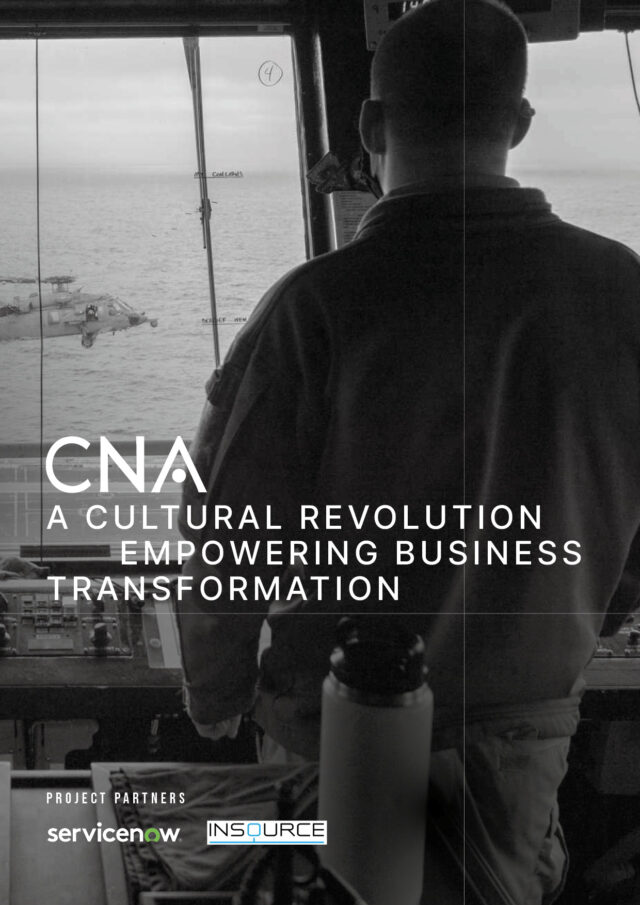Through a digital transformation, how can Aviva Italy better serve its digitally enabled customer?
One of the biggest industries in the world has, almost unbelievably, found itself saddled with an antiquated label. With global insurance premiums reaching more than $3trillion in value, it’s no secret that the insurance sector is one of the key markets and yet even now in 2021, with the total digitalisation of business, insurance is still finding itself lagging behind. The question then becomes a simple one: why? And more importantly, what are insurers doing to shake off this label?

“Our Italian General Insurance (GI) CEO always says that we as an insurance company are fighting a battle on behalf of the unsatisfied customer against the traditional complexity and lack of clarity of the insurance industry,” explains Lorenzo Chiofalo, Head of Innovation at Aviva, Italy. “Technology is simply our enabler to defeat the sense of mistrust that customers have towards the insurance industry.”
With over 30 million global customers and 2.3 million in Italy, Aviva is one of only a few insurance companies in the world that can provide customers with life, general and health insurance, and asset management in one place – a composite insurer. Recognising that the insurance industry needs to address the challenge of continuously adapting to an ever evolving digital world, Aviva Italy embarked on a significant transformation of its operating model in order to provide innovative solutions that places the digitally enabled insurance customer right at the very heart of its services ecosystem. Simply put, the transformation journey started with the desire to get rid of the perception of insurance as antiquated, slow and ineffective. This drove Aviva to take on board a greenfield approach.
“Starting everything from scratch we have been able to remove the many constraints faced in the past with the old processes and systems,” explains Chiofalo. “As we had no bindings, we have been free to design the system we wanted, around the proposition we wanted. This helped us to minimise risks, fail fast and disrupt the way customers were facing the insurance business.”
“We set customers and their needs at the centre of a new ecosystem of services that we have been able to develop fast and fine tune afterwards. In just a few short years, we have shaped new product propositions and gained expertise with new touch points to get our AvivaPlus offer wider and up to date.”
Chiofalo recognises that while the company needed to effectively start from scratch in order to build this new system, it was fundamental that it needed to address the modern insurance customer. The customers of today are digitally empowered in almost every way, with access to so much information in the palm of their hand and this has forced many organisations to rethink how they must cater to them. He even goes as far as admitting that this has changed the traditional competitors of the insurance space.” Competitors for insurers are not insurers themselves anymore,” he says. “We need to look to other business models to offer the experience that customers are looking for: freedom to choose how and when to manage policies or ask for services and a no frills experience and flexibility.”
This is where he speaks of Spotify and Netflix as key influences on this new approach to insurance services. Customers are looking for experience, as Chiofalo notes, rather than a simple purchase and they establish a relationship with the brand more so than the product itself. This is not unique to Aviva customers, or indeed unique to insurance customers overall, but it is a major challenge that many organisations are still looking to address. “Digital is a new ‘paradigma’. It is a new way to manage the relationship between customer and insurer based on new touchpoints that exist in an omnichannel ecosystem,” he says. “This is the reason why we started our journey to become one of the most innovative insurers in the market.”
So the goal for Aviva Italy was quite clear, but for any insurance organisation there’s going to be a common challenge of addressing a so-called technology debt. As Chiofalo has highlighted, technology is the enabler of all kinds of business. The IT ecosystem, based on technology infrastructure, devices and software, is evolving at such a pace that it is undoubtedly difficult for a non-tech company like Aviva to close the gap without creating a technical debt and start the way for obsolescence. “Companies must bridge this gap,” he says. “Staying current is the only way to enable innovation. A key example is a Cloud native solution. This is a game changer, as the Platform (software and Infrastructure) will already embed the latest technology by design, avoiding any gaps.”
And so the scene was set for Aviva; implement a cloud-native SaaS model that would truly change the game for the way Aviva works with its customers and provide insurance services. In a world awash with technology, and an industry that’s aware of its own technology debt, finding the right solution was crucial and Chiofalo had to start by identifying the why before looking at the what. Here he speaks of how an SaaS model will allow Aviva to focus on its core business, leaving the non-differentiating technology topics to a partner. Aviva Italy chose Guidewire to manage the P&C core applications as enablers for its transformation.

With Guidewire, Aviva Italy had access to good software while also ensuring that any future operating model would seamlessly work with Aviva’s current technology. In an industry as suspect to disruption and change, “uncertainty is probably the main certainty thing in these times”, adds Chiofalo.
The Guidewire Cloud solution will enable Aviva to be focused on the core business, shifting any technological aspects into the hands of a technology company. It provides the software, manages the infrastructure and ensures quality of software through the Cloud Assurance and quality of the service through specific SLAs. This software is also upgraded twice per year by Guidewire itself, improving benefits in several areas: providing new technology based on APIs/microservices integration, rules engine that can be easily configured and Plug&Play Solution extensions through the MarketPlace.
“What this means for us is that it is improving the digital capabilities for a better customer experience and final user engagement,” says Chiofalo. “They are innovating the platform with new features, like the Advanced Product Model which empowers our business users in the Product modelling and design.”
This ultimately means that Aviva Italy can truly turn the old paradigma on its head. Where once the business would ask for new features that the IT department must then implement, technology becomes the fly-wheel for the business in which it, proactively, suggests new features, innovations and new technologies for business and final users.
Cloud software is not a new concept, but it is one that remains something of a challenge for some businesses when it comes to truly understanding the power it possesses. As Chiofalo can now attest to, companies would upgrade their software and technology every 5-7 years and, due to cost complexity, they would upgrade as less as they could. “Thanks to the Cloud, the software is constantly upgrading to the latest and greatest software version and users can toggle the features provided, as needed,” he says. “Moreover, in adopting the Guidewire Cloud Solution, Aviva Italy can rely on huge R&D activities, with the opportunity to adopt the most advanced features.”
When addressing technology debt, one can be forgiven for getting carried away as you focus on the changes and the future and the outcomes. But what about that existing technology and infrastructure? You can’t just switch it off and start fresh. “You need to build up a solution that lasts over time and cannot consider past experiences. This is important to avoid the mistake of following the ‘we’ve always done in this way’ approach that comes with any change,” says Chiofalo. “We’re not in the era of replacing an application on a simple feature-by-feature comparison anymore. I believe that the most important aspects are related to the ability to embrace the change and its evolution, which should be embedded in the way the software has been built but also on the corporate culture and methodology.”
Naturally with any transformation there requires a conversation around operational buy-in. The main question will often be: is this right for the company? Chiofalo admits that this is the most important prerequisite for any initiative that he and Aviva look to implement. “To maintain and nurture sponsorship achievement in transformation projects, whose duration spans over years, is hard,” he says. “So there are two key ways that we do it: first, evolve fast, and prove continuously that the journey is happening and second, be able to engage the entire organisation in the purpose, turn the transformation initiative into every employee’s initiative. This is crucial.”

This transformation journey was born back in 2019, with a new product developed and the greenfield approach ready to begin. Throughout 2020, Aviva Italy had successfully been able to re-design, improve and implement all major Personal Line offerings (householders, mortgage, fire, personal liability, personal accident, SME, catastrophe) as well as launching its first Commercial Line offering: product liability. During this time the company had also successfully worked through its legacy decommission. As we speak in 2021, the focus will be moving forward with the Guidewire Cloud Solution.
It would be remiss of us not to discuss the COVID19 pandemic and the impact it has had, not only on the world around but on businesses such as Aviva. Now faced with a dramatic shift in customer behaviour, where customers were not able to manage their policies face-to-face with their intermediaries, agents were required to interact with electronic signature and remote payments. A process that Chiofalo admits that even just a few weeks before the pandemic they were very reluctant to do so.
Agencies were closed during national lockdowns and processes needed to change ‘in a snap.’ Insurance regulators demanded an immediate intervention to ensure coverage and assistance to all insured customers. Aviva Italy faced the immediate, urgent need of an unprecedented flexibility in terms of processes and services changes. But the pandemic has in many ways, presented great opportunities for reflection and for growth.
Aviva Italy had already embarked on this transformation journey, following three main drivers which allowed the company to mitigate the challenges of the pandemic, continue its transformation journey and most importantly, be there for its customers.
These drivers were Technology (first-in-class software to be always flexible and adaptive combined with Guidewire Cloud), Agile methodology: a companywide agile approach, learning a new culture based on open collaboration where ideas win on hierarchy and Open Innovation (open to externals, open collaboration, open business model and an open ecosystem). “Through our approach and our key drivers, we were able to move faster and really be there for our customers during this difficult time,” says Chiofalo.
As we look to the future, Chiofalo and Aviva Italy can be proud of what it has achieved so far along this journey. As the first insurer in the Country to adopt the only SaaS solution in the insurance market, Aviva certainly has a competitive edge as the Guidewire Cloud solution truly removes the shackles of an older model of insurance. Chiofalo is cautious, acknowledging that a journey like this takes time in order to succeed. “This new model, like any new model at the beginning of its journey, requires time to land in a steady-state phase. We take the risk by adopting a new model as first-mover because this is in the DNA for those who want to innovate,” he says. “Being the first in today’s economy is important as the comparison between alternatives has profoundly changed. As consumers, we are no longer looking only at price and quality, we look to emotional factors and to the experience. I like to think that Aviva in Italy is a forerunner in innovation inside the insurance market and being so enabled us to continue our journey even in the most complex timing during the pandemic in Italy, and will allow us to continue to provide the best services and solutions that our customers want through an experience that strikes a key connection with them.”









